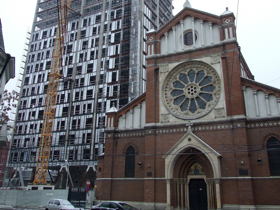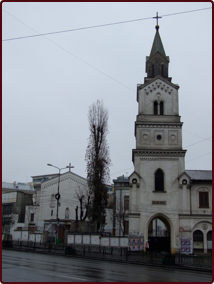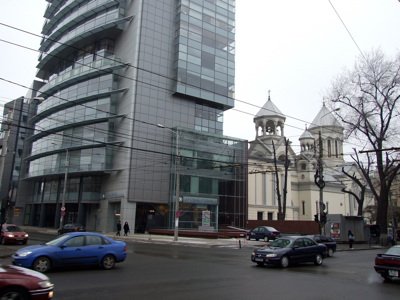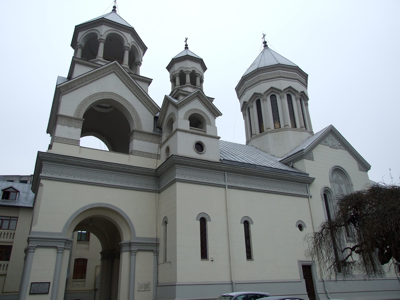The Italian Church. It was built in 1911-1915, following the plans of Architect Mario Stoppa. The church has a facade made of apparent brick, which brings a bit of colour on the otherwise quite grey Nicolae Bălcescu Avenue. The facade was designed in Neo-Gothic style. Services are held in Romanian, German, Italian and Polish. The building is owned by the Italian government. GPS - N44 26.377 E26 06.033
The Russian (a.k.a. Students’) Church. Russian Ambassador Mihail Nikolaevich de Giers built a Russian church in Bucharest, merely for the use of the embassy staff and for the Russians living in the city in 1905. The church was designed by Architect Preobrazhenski and the Russian Imperial Court paid for the building. The church was built of compressed bricks and stone, the Russian style being obvious especially in the 7 steeples initially covered in gold. The iconostasis was carved in wood and covered in gold, being produced in Moscow, following the model of St. Apostles Church in the Kremlin. It was painted by Vasnetsov of the Moscow's Tretiakov Gallery. The church was accomplished in 1909. During WW1 it was closed, its valuables being transferred to Iași and then to Sankt Petersburg, where they disappeared during the Russian Revolution. After the war, service started again in 1921 and the church was restored with the help provided by Russian emigrants; it became popular not only with Russians living in Bucharest, but also with Bulgarians and Serbs, as the service was conducted in Old Slavonic. In 1935, as the old Russian priest had died and the government in Moscow was no longer in favour of religion, a Romanian priest was assigned and the church was given to the Romanian government. It was used by the University in Bucharest, fact that granted its nickname of "Biserica Studenților" (En. Students' Church). In 1947, at the Soviets' request, the church was given back to the Moscow Patriarchate jurisdiction, just to be given back to the Romanian government in 1957. The Romanian Orthodox Church had it restored and re-baptized it in 1967. In 1992 the Romanian Orthodox Church gave it back to the students, according to the interwar tradition. GPS - N44 26.033 E26 06.101
The Lutheran Church. In 1574 Pierre Lescalopier mentioned the existence of a Lutheran church in Bucharest, in the Stejarului (En. Oak) Quarter. However this church was accomplished on July 4, 1777; it was built mainly for the Transylvanian Saxons living in the city, and its construction was possible thanks to the pressure exercised by the King of Sweden through his Ambassador in Constantinople. Next to the old church there was raised a more imposing one between 1851 and 1853; it was the tallest structure in the city at its time (36 m. tall); important figures of the time contributed to its being raised: the Austrian Emperor, Prince Bibescu, Composer Franz Liszt among others. The church also hosted around it an important Girl School, which reached 2000 pupils and 64 teachers in 1910. The church was damaged by a great fire in 1912, and also during the 1940 earthquake. The 1944 Allies' bombardments destroyed most of the adjacent buildings (the parish house, the school). It was restored in 1994. The church hosts the grave of Principe Wilhelm Friedrich Heinrich von Wied (1876-1945), ruler of Albania in 1914, nephew of Queen Elizabeth of Romania. GPS - N44 26.435 E26 05.575
The Anglican Church. In 1900 the City Hall donated a plot of land of 326 sq.m., on which, at the request of British Ambassador John Kennedy there was built the Anglican Church of Resurrection. After WWI was over, the church was accomplished through donations done by the Bishop of Gibraltar and Queen Maria of Romania. The first service took place in 1920, but the church started operating on a regular basis in 1922. Until its opening, the British community in Bucharest had used a small room provided by the Synagogue on Olteni Street. The church lies on the crossing of Arthur Verona and Dionisie Lupu streets. GPS - N44 26.573 E26 06.145
The Greek Church. Evanghelismos Society bought a plot of land from the City Hall and began the construction works in 1899. Until the building of this church, the Greek community in Bucharest had used Lazaris Kalenderoglu Church on Doamnei Street (nowadays the Bulgarian Church). The land where they built the church was close to the old Greek cemetery (which used to stretch all the way to the actual Foișorul de Foc, see my special tip on it). The monumental church has the shape of an antic temple, and it bears on its Western and Eastern facades 6 canelled columns with Ionic capitels. On the long sides it has 10 columns. Inside, the church is divided in 3 naves, separated by Corrinthean columns. The church was reinforced with steel bars. It is surrounded by a forged iron fence and the Greek Embassy lies behind it. Together with the Museum of Maps and Old Books (see my tip on it), the guards here are granted the Most Imbecile People on Earth Award. If you want to shoot pictures, do that quick and run away, for the guards seem sensitive to cameras and brains. I for one was lucky to be on a bike. GPS - N44 26.312 E26 07.060
The Bulgarian Church. Sfântul Ilie-Kalinderu Church belongs to the Bulgarian community in Bucharest. It was built between 1725-1730 by Boyar Radu Colțea and it used to be known as Sfântul Ilie Church of Colțea Inn, as it used to be hosted in the inner yard of this inn. The church collapsed during the 1838 earthquake, but it was restored by Lazar Kalenderoglu, the inn keeper of Colțea Inn. Between 1880-1897 it worked as a Greek church, with service being held in Greek. Starting with 1897-1898 it hosted the service in Romanian once again. Later on, it was granted by the Romanian Orthodox Church to the Bulgarian community in Bucharest (1954). The church lies in a back yard just off Doamnei Street (coming from Bălcescu Avenue, the yard lies to the left, after passing a building with brightly painted Oriental style window frames). GPS - N44 25.979 E26 06.171
The Armenian Church. The church was built between 1911 and 1915, and it was designed by architects Dimitrie Maimarolu and Grigore Cerchez. The structure followed the pattern of Vagharšapat - Ečmiadzin Cathedral in Armenia. The painting was initially done by Painter Bassano and it was restored by Eugen Profeta in 1971. The complex includes the church proper, the bishop’s residence, the Armenian library, a small museum, a cultural centre and the headquarters of the Armenian Union in Romania. The church was involved in a scandal, when the City Hall approved the building of a tall office building next to the library building, which affected both this one and the church proper.
GPS - N44 26.246 E26 06.647
St. Joseph Catholic Cathedral. The cathedral was built between 1873 and 1884, with funds being provided by the Catholic community in Bucharest and abroad. It was designed by Architect Carol Berisch. The main altar was made in Rome of Carrara marble. The painting was done by Georg Roder. The initial stained glass window panels were done in Munich, but they were destroyed during the 1944 bombing over Bucharest. The actual panels were done by Natalia and Ion Brodeală (1980), respectively Dorin Dănilă (1985). The actual organ was built in Timișoara in 1930, as it replaced the original one, brought from Paris in 1892. Just like the Armenian Church, the cathedral was involved in a scandal, as the City Hall approved the building of a tall office building next door, fact that affected its structure.
GPS - N44 26.541 E26 05.486
Bărăției Catholic Church. A Catholic church was mentioned by in documents ever since 1578. In 1637, Voyevode Matei Basarab contributed to the building of a Catholic church in Bucharest, at a time where religious wars flourished in Europe; the church was destroyed by subsequent fires and earthquakes, but it was always rebuilt and restored. Bărăția Tower was built in 1813, with a square shape reminding of Gothic church steeples. In 1833, on the site of the old church, a Franciscan monastery was built. Both the church and the tower were restored after the great earthquake of 1847. The actual looks of the church were given during the restoration in the 1930s, while the tower was restored has been granted this shape during the 1860 restoration. GPS - N44 25.858 E26 06.251

























